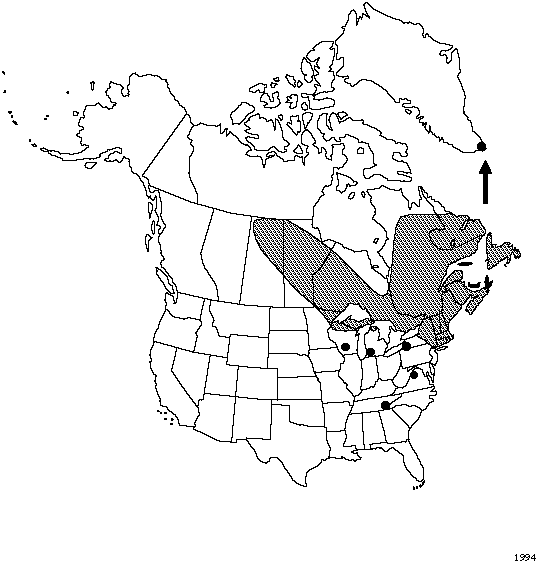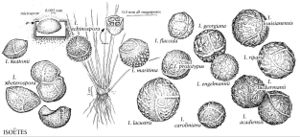Isoëtes lacustris
Sp. Pl. 2: 1100. 1753.
Plants aquatic, submerged. Rootstock nearly globose, 2-lobed. Leaves evergreen, dark green to reddish green, pala brown toward base, spirally arranged, to 25 cm, rigid, abruptly tapering to tip. Velum covering less than 1/2 of sporangium. Sporangium wall ± brown-streaked. Megaspores white, 55–750 μm diam., cristate to reticulate with branching to anastomosing ridges; girdle densely papillate or rarely smooth. Microspores gray in mass, 33–45 μm, paillose. 2n = 110.
Phenology: Spores mature late summer.
Habitat: Cool, oligotrophic, slightly acidic lakes and streams
Distribution

Greenland, Man., N.B., Nfld. and Labr. (Nfld.), N.S., Ont., P.E.I., Que., Sask., Conn., Maine, Mass., Mich., Minn., N.H., N.Y., R.I., Tenn., Vt., Va., Wis., n, c Europe
Discussion
Population of Isoëtes lacustris in Tennessee and Virginia are disjunct.
North American plants of Isoëtes lacustris have been segregated as I. macrospora; both taxa are decaploids (2n = 110) and have similar leaf and spore morphology. Then cannot reliably be distinguished from each other except on the basis of geography.
Isoëtes lacustris is a totally submerged aquatic. Plants have been found at depths of more than 3 m. Plants with rugulate megaspores bearing smooth, rounded ridges and a smooth girdle have been called I. hieroglyphica A. A. Eaton [I. macrospora f. hieroglyphica (A. A. Eaton) N. E. Pfeiffer].
Isoëtes lacustris hibridizes with I. echinospora [ = I. x hickeyi W. C. Taylor & Luebke]; I. engelmannii; I. riparia [ = I. x jeffreyi D. M. Britton & Brunton]; and with I. tuckermanii [ = I. x harveyi A. A. Eaton].
Selected References
None.
